What to do with a large Western juniper with one large branch that grows the wrong way? Bend it. To bend juniper branches over 2″ in diameter, hollowing out the branch before bending greatly increases the severity of the bend one can apply. Ever since Kimura popularized the technique in Kindai Bonsai and later in the English language compendium of his early work, The Bonsai Art of Kimura, bonsai artists around the world have been gouging out branches willy-nilly. When done well the technique can be a crafty solution to otherwise insoluble bonsai dilemmas.

Gouged-out branch with aluminum wire
Gouging out branches is best done with small, circular saw blades. The trick is to hollow out as much as possible but not too much as breaking through to the cambium on the other side of the branch greatly decreases the integrity of the branch and bites into the very few paths that will keep the branch – and in this case the tree – alive. The gouged-out area is filled in with aluminum wire to preserve the shape of the branch during bending. Performing sever bends to hollow branches can easily yield flattened, broken branches.
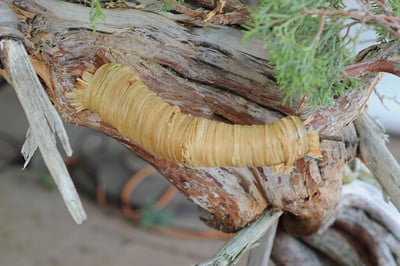
A well-wrapped branch
After filling the branch cavity with aluminum wire the branch is wrapped tightly in raffia. The first layer of raffia is placed lengthwise on the outside of the bend and then held in place with tightly spiraling loops. Well-wrapped raffia is secured with as few knots as possible to avoid the possibility of uneven pressure being applied to the branch when it is wired or bent.
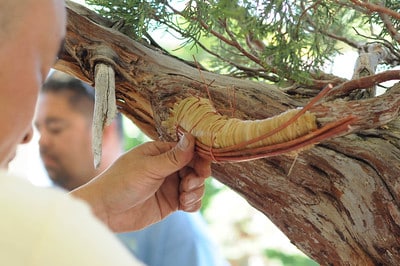
Reinforcing wire
Large copper wires are then placed on the outside of the bend. These wires will help keep the branch intact and the bend in place.
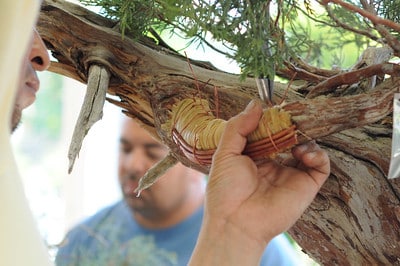
Securing the reinforcing wires
The large copper wires are temporarily held in place with wire. At this point a second layer of raffia is applied to hold the large copper wires in place.
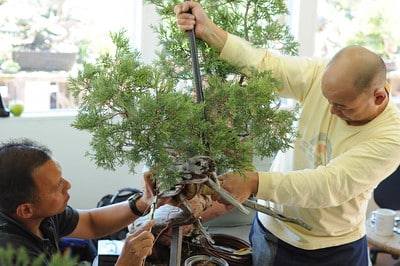
Boon, “Jackie,” and Kondo
All of this preparation is required to make the next part of the process a success. Jackie is enlisted to provide leverage, Kondo provides strength, and Boon removes slack from the line that will keep the bend in place.
The primary challenge for this bend was figuring out how to set up the jack. Several wires were needed to keep the jack in place and additional rubber padding was used to protect the spot where the jack pressed against the branch. Brute strength, however, was required to get the bend going.
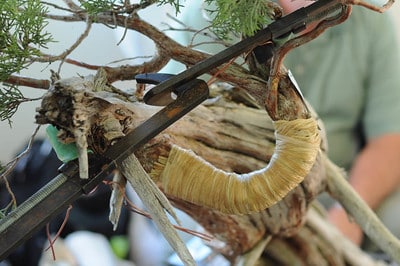
Double jacks
Once the branch had more angle to it, the bending continued in a more civilized manner with the assistance of two jacks.
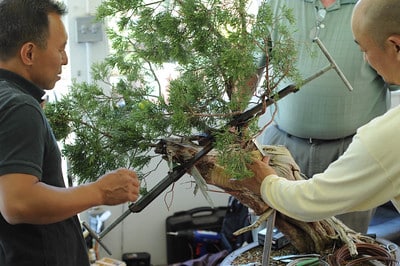
Using two jacks to make increase the bend
The danger here is that it becomes easy to over-bend with little effort. Kondo performed this part of the bend incrementally while paying close attention to the various stress points along the branch.
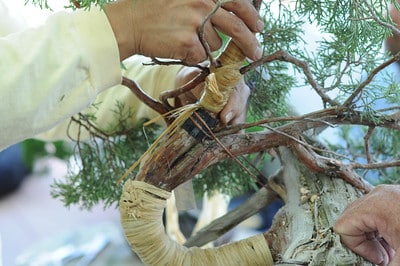
A second bend takes shape
Once the bend reaches the appropriate angle, the work is secured with a single copper wire. From here more raffia is applied, more branches wired, more progress made.
This large bend completed Kondo and John’s work for the day. The next day they wired the main branches and put the tree back on the bench. The main task for the coming year is to keep the tree as vigorous as possible to help set the bends – perfect preparation for next summer’s workshop.
Subscribe to Bonsai Tonight
New Posts Delivered Every Tuesday and Friday
tom tynan says
With this technique – what will happen long term to the gouged out area ? Does cambium roll over the gouged out void and create a healed joint – encasing the alum wire. Nice photos in this series….regards Tom
xwires says
Good question. Kondo suggested that the the aluminum wire be removed in a year or two. Due to the size of the gouge, I imagine it will remain open and hollow on this branch. When this is the case, it’s important to hide the opening from the front of the tree as it’s not very attractive. On some branches only a ribbon of live wood is left which, when it heals, can look somewhat natural.
The main alternative to this technique is grafting. While both techniques can work very well, grafting typically requires more time to achieve the same results as bending.
John Kirby says
Was an interesting weekend, Boon and I had previously thought the tree looked best from the angle chosen, but getting the branch bent and keeping the tree alive were concerns. There were concerns that only getting the branch halfway bent would essentially ruin it, so there was a little excitement in getting both of the big bends done, getting the branch moved to a reasonable position for it to become the “tree” in essence. It was a lot of fun working with Akio Kondo, he brought a lot of humor and perspective to the process.
John